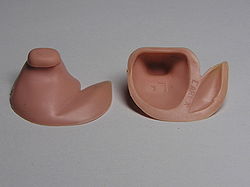Earplug

An earplug is a device that is meant to be inserted in the ear canal to protect the wearer's hearing from loud noises or the intrusion of water, foreign bodies, dust or excessive wind.
Protection from water
Some earplugs are primarily designed to keep water out of the ear canal, especially during swimming. These may be made of wax or silicone which is custom-fitted to the ear canal by the wearer.
An effective and simple ear plug to block water from the ear canal is a cotton ball saturated with petroleum jelly. (Gently knead an equal volume of cotton ball and jelly together. Cut into bean sized plugs.)A 2003 study published in Clinical Otolaryngology, found that the cotton ball/petroleum jelly ear plug was more effective at keeping water out of the ear, easier to use, and more comfortable than wax plugs, foam plugs, EarGuard, Aquafit, or EarSeal. The cotton ball/petroleum jelly plugs are not intended as hearing protection.
Hearing protection
'Basic' type plugs

Current earplug material was discovered in 1967, at National Research in the USA, by Ross Gardner and his team. As part of of a project on sealing joints, they developed a resin with energy absorption properties. This E-A-R material was later developed into commercial memory foam earplugs.
This kind of earplug protection is often worn by industrial workers who work within hearing distance of loud machinery for long periods of time. Earplugs are rated with "Noise Reduction Ratings" or NRRs (Single Number Ratings, or SNR, in the European Union), which provide a guide to the noise protection, in decibels, afforded by the device. Ratings usually spead between 26 to 33 decibels.
Most earplugs are made of memory foam that is typically rolled into a tightly compressed cylinder (without creases) by the wearer's fingers and then inserted in the ear canal. Once released, the earplug expands until it seals the canal, blocking the sound vibrations that reach the eardrum. Other plugs simply push into the ear canal without being rolled first. Sometimes earplugs are connected with a cord to keep them together when not in use. Other common material bases for earplugs are wax or silicone, which is rolled into a ball and carefully molded to fit over the external portion of the ear canal, providing a snug custom fit for the wearer.
Other devices that provide hearing protection include electronic devices worn around and/or in the ear, designed to cancel out the loud noise of a gunshot, while possibly amplifying quieter sounds to normal levels. While rich in features, these electronic devices carry a price over one hundred times their foam counterparts.
Since they reduce the sound volume, earplugs are often used to help prevent hearing loss and tinnitus (ringing of the ears), amongst other ailments.
Musicians' or 'Hi-Fi' earplugs
Some earplugs are manufactured to provide a direct decibel drop without affecting the user's perception of bass and treble levels. These are commonly used by musicians and technicians both in the studio and in concert to avoid overexposure to high volume levels whilst providing a good balance over the frequency range.

Musicians who perform music styles noted for their loud nature, especially rock music, often wear earplugs to prevent their own performances from damaging their hearing.
Musicians' earplugs are designed to attenuate sounds evenly across the audio band thus enabling musicians to still hear upper harmonics, vocals, cymbals and other high frequencies etc clearly, but at a reduced volume level. This type of earplug usually gives an attenation of only about 20dB and are not intended for protection from very high noise levels (>105 dB). Earplugs for musicians are made by a number of firms.
By far the best "Musicians" earplugs are those that are custom made for the individual listener. This involves taking a trip to an audiologist to have a hearing test done and getting the molds made to send to a company. That company will then make the customer a custom set of molds that different capsules can be put in. These different capsules will provide different levels of attenuation, usually 9, 15, and 25dB SPL. These types of earplugs will provide the flattest attenuation and the truest isolation from outside noise, as they fit firmly into the individuals ears.

Flight ear protection
Earplugs are available which help to protect ears from the pain caused by airplane cabin pressure changes. A product called EarPlanes (TM) manufactured exclusively by Cirrus Healthcare Products, LLC, contains a porous ceramic insert which aids equalization of air pressure between the inner and outer ear thereby preventing pain during landings and take-offs. Template:Polytonic The effectiveness of this relatively inexpensive pressure equalizing earplugs has been proven in controlled laboratory tests and is an aid in the prevention of baurotrauma.
